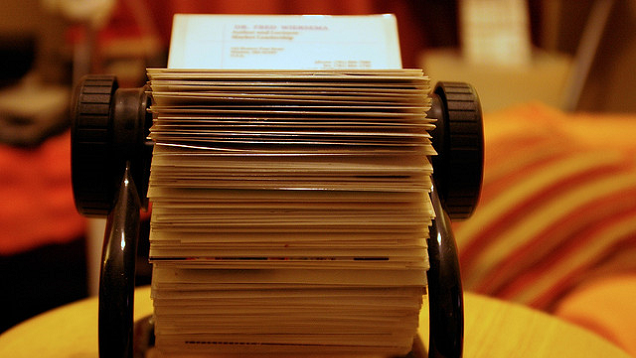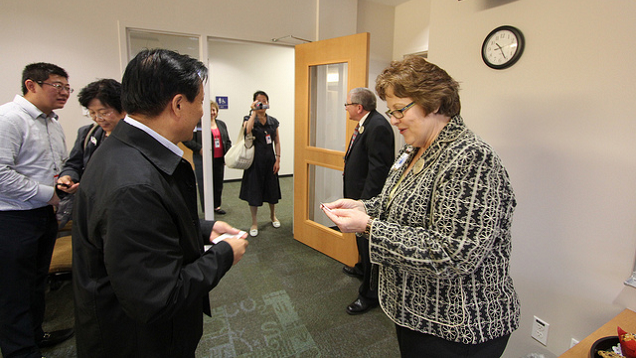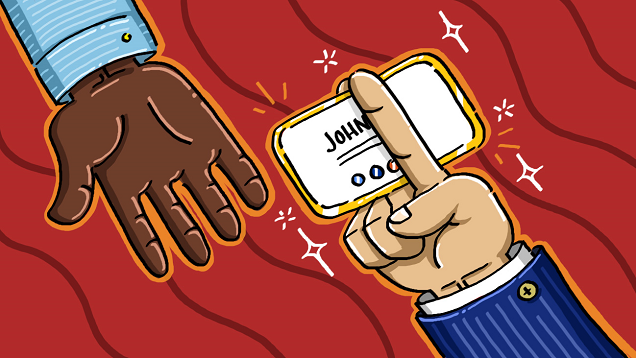With most business being done digitally, you might think that business cards don’t matter anymore. But they can offer a lot. Here’s why they’re still important for business and how you can get the most out of yours.
Photos by Tina Mailhot-Roberge, Ged Carroll, J Aaron Farr, Texas State Library and Archives Commission
Why Business Cards Still Matter

Business cards still matter because our memory sucks. How many times have you met someone, spent most of the conversation thinking of what to say so you don’t sound stupid, then promptly forgetten their name when it’s all over? Mitchell Friedman, associate dean of student affairs and career development at Presidio Graduate School, explains:
…when you meet a person at a business event, get their business card. Perhaps even write a note or two on the reverse side of the card to capture the key points of your conversation while they’re still fresh in your mind. The bottom line here is to have a physical record of contacts you make so you can follow up as appropriate in conjunction with your broader job search/career development efforts.
A business card is a road map to opportunity. It could lead you to a new job, a business partnership, or simply help your company make money. Think of a situation where you you’ve got your networking pants on and you’re looking to benefit your business by making contacts. Suddenly, you notice someone that could be a potential client. What do you do? You introduce yourself and describe what you do, but at some point, you’ll need to hand off your contact information. A business card saves you time and makes you look professional. You’re not fumbling around with a pen to scribble your email address on a cocktail napkin, and you also give them a sense that this isn’t your first rodeo.
Not only is your first impression important, but business cards provide tangible information for others. Writer Sarah Brooks at Successful Blog explains that it gives them something physical to refer to later should they decide they want your product or service:
Business cards put a face to a business — When meeting someone new, handing them your business card (preferably with your photo on it) will help keep your business in the back of their minds. Though they may not need your product or services today, there may come a time when they do, and hopefully they will be able to pull out your business card and call versus trying to remember your company name and searching the web.
Your business card is a physical object that potential clients can take with them that keeps you or your brand from just being a name that floats around in the ether. It’s great if you have a web site, but commercial printer Shaun Caldwell explains on his LinkedIn blog that cards have certain perks:
Business cards never have downtime. They’re always accessible, and never have dead zones or Internet outages. Your business card can be viewed no matter where you are located, and even times when cell phones and other devices must be turned off, such as on an aeroplane ride or in a hospital. Your business card is always working for you.
Not everyone thinks business cards are essential, and some argue business cards have lost their edge. Ilya Pozin, writer for Forbes and Inc., describes a shift he’s seen:
As for me, I haven’t had business cards for many years either. Instead, I make a point to ask my new connection to email me. (When I respond, I include my full contact information.) It’s become normal to see people at networking events in L.A. using their phones to collect contact information right there on the spot. Fast-forward a few years, and it won’t be surprising to find Google Glass-wearing techies exchanging contact information by looking at each other.
Technology, and — more specifically — smartphones have made information sharing easier. These days you can email someone while you’re meeting them with a few quick taps of your thumb. There are even apps out there that can share contact information with someone with barely any effort at all. So why bother with a card when you have all of this other stuff? Networking is about making meaningful connections, and sometimes technology — or the act of using it — can be impersonal.
Meeting someone in person only to look down at your phone and start tapping can seem rude and disconnected. You want to smile, make eye contact, and make the conversation you’re having be your main focus. You don’t want to be hoping they have the same information sharing app, asking for their email immediately to send your info, or looking down at your screen. Technology can still be used to enhance your experience, however. Apps like Evernote can scan the business cards you collect and make storage and organisation easier. But business cards already use one of the best information sharing apps out there: your hands. Until we actually can look someone in the eye to share information, you’re better off keeping conversations personal and connected.
Business cards are cheap, portable, and easy to give away, so there’s no reason not to have one. Even with email, LinkedIn, Facebook, Google+, and Twitter, people expect you to have a business card. It shows professionalism and it demonstrates that you care. In a sense, business cards are a way for you to say, “I belong here, I know what I’m doing, and you should consider me a factor.” They are a paper handshake that instantly gives whoever you meet everything they need to know in order to do business with you.
What Should Be On Your Card And How To Make It Stand Out

What goes on your business card largely depends on what kind of business you’re in — or want to be in — and whether or not you have the ability to make your own. If you work for a large company your card might be predetermined. Either way, there are a few essentials you should include.
Be deliberate about the information you include and keep clutter to a minimum. You don’t want the most important bits of information getting lost in a mess of words and numbers. You need your name — or name you go by — and job title on the card, along with the name of your company or what you do. List your business phone number, work email, web site, and possibly the location of your business if that’s important to know.
Put your information on the front and leave the back blank. If you’re adventurous you can experiment with different styles or maybe a logo on the back, but for a solid card style you can rely on keeping things basic. Writer John Williams at Entrepreneur recommends keeping the back of your card blank:
How often will people see the back of your business card? Traditional card storage modes assume that side is blank. If you do wish to put copy on it, be sure the information is of a supplemental nature: e.g., your company’s mission or tagline. While business cards should promote your brand identity, they shouldn’t be confused with advertising.
Use white as the base colour of your card. That way, people who have received your card can write visible notes or additional info on the front and back.
Stick to the standard size of 2″ by 3.5″. It may seem like an easy way to make your card stand out from the crowd, but more than likely you’ll get your card tossed because it won’t fit in someone’s wallet or other business card holder. Remember, the idea of the business card is give them reference information after you’ve wowed them or pique their curiosity so that you can wow them later on. You don’t necessarily need to wow them with bizarre card shapes or confusing designs.
Use your photo and add value to your card.Susan Adams at Forbes spoke with online marketing consultant Don Crowther, and he suggests putting your gorgeous mug on your card:
Why include a picture? “You go to a convention, and you come home with 55 cards in your pocket,” Crowther says. If one or two cards have photos, you’ll remember those people.
Crowther also suggests that including some sort of incentive on your card will increase the likelihood of others getting in touch with you. You can offer discounts, special services, or even advice if that fits your business. You want people to remember you and feel like getting in touch with you will benefit them.
On the US Small Business Administration blog, writer and CEO of GrowBiz Media Rieva Lesonsky shares some other tips on standing out worth considering:
- Incorporate QR codes: The jury is still out on this, but for some professions — like tech-related careers — QR codes can be a great way to direct people to a web page filled with important information that could never make it on a card. It also, however, takes up a great deal of space, so don’t let it become clutter.
- Spend more on quality: You can buy basic business cards for very cheap, but you may want to consider the message you’re sending with cheap paper and print jobs. Think of how a nice magazine feels in your hands compared to a floppy tabloid. Regardless of what’s inside, the magazine feels better and seems more professional.
- Choose the right font: Keep your fonts 12 points or larger and make sure they are legible! It’s ok to play around a little here, but if you’re even a little bit concerned if others will be able to read your card, pick something else.
- Consider professional help: One way to ensure you get what you need is by hiring someone whose job is to design. Graphic designers know their craft and they can come up with something clever, informing, and professional.
All in all, there are three keys to a perfect business card: it contains all vital information needed to contact you, it entices people to learn more about you or get in touch, and it stands out without being too different.
The Best Business Card Practices

With the right card, you’re ready to network your butt off. Here are some strategies that can make sure the handing over of your card doesn’t go to waste. After all, you don’t want to go through the trouble of making — or buying — the perfect design if they’re not going to get good use.
- Be prepared: Always have business cards on you. Always. Even when you’re on holiday you might make a connection with someone. Keep a few in your wallet and you’ll be good to go.
- Be selective: You may have a thousand cards, but that doesn’t mean you need to use them all at one conference. Tossing your card at every single person you meet will get them tossed in the trash and waste your cards. A good rule of thumb is if you shook their hand after making a connection, hand over your card.
- Be interested: If you hand over a business card, try to get one back. Most of the time they will try to reciprocate when you give them a card, but if they don’t, ask. Showing your interest in them can increase their interest in you, and it never hurts to have their information for reference.
- Be proactive: When you do get their business card, take some time to look them up on LinkedIn, Twitter, or wherever else they may have listed themselves. Doing this will help you remember the names of the people you meet and often let you put a face to the name. Now when they shoot you an email, you’re not trying to decide if it’s the guy you sat next to or the guy you talked to outside of the bathroom.
Keep these business card basics in practice and you’ll come across as professional while potentially saving yourself a headache down the road.
There are lots of ways to get into people’s contact lists, but business cards are still a mainstay in the professional world. They’re cheap, simple, and efficient at delivering all the information you need.

Comments